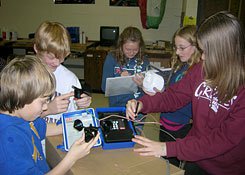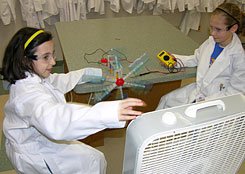Wind Turbines Fuel Learning
As alternative energy takes center stage, a national program teaches the science and power of the wind.
Turning to the Future:
Workers slowly place Sleeping Giant Middle School's new wind turbine.
Credit: Courtesy of Lewis GunnIn tiny Livingston, Montana, the living is good -- if windy. "The wind is just always present here," says resident Lewis Gunn. "It's the litmus test that keeps our community small. Not many people can put up with it."
Gunn, who teaches science and technology at Sleeping Giant Middle School, now has a reason to celebrate the wind -- a small wind turbine recently installed on campus. The school obtained the turbine through a national program designed to educate students about this form of alternative energy and, ultimately, to inspire a new generation of wind-energy scientists.
Wind for Schools
The program, called Wind for Schools, aims to provide students, teachers, and communities with an up-close look at how wind energy works through a combination of turbines and a free K-12 curriculum developed by the National Energy Education Development (NEED) Project.
Sponsored by the National Renewable Energy Laboratory's Wind Powering America program, Wind for Schools launched in six windy states -- Colorado, Idaho, Kansas, Montana, Nebraska, and South Dakota -- but teachers can use the curriculum anywhere, with or without a turbine.
K-12 schools apply to participate in the program and, if chosen, work with their state's Wind for Schools facilitator to raise the $6,000 or so (excluding labor) necessary to buy a 1.8-kilowatt turbine. (Schools can expect to pay about $1,500 of this amount.)
The turbines generate about 3,800 kilowatt hours a year -- not enough to save schools much money on utilities; the main point is the learning opportunities. But it is enough for schools to recoup costs in five or six years.
"Our goals are twofold," says Ian Baring-Gould, senior engineer at the NREL. "First, if the nation is going to embrace wind technology as a major supplier of energy, we need to develop an educational infrastructure to support that.
"Second, the Wind for Schools program helps introduce wind technologies to rural communities in the heartland, where the resource is," he adds. (For an introduction to wind energy, see "How Wind Turbines Work," from the U.S. Department of Energy.)
Hands-On Science
In Lewis Gunn's classroom, the program is proving successful. Using meteorological data such as wind speed, wind direction, and air density, students predict what the turbine should do. "They form a hypothesis and use tools to test it," Gunn explains. "It's a good way to tap into the scientific method."

Wind for Schools includes software that connects the turbine to the classroom, which allows students to see how much power output they're actually getting from the machine. Based on this information, Gunn's students create graphs of wind speed versus power output.
"Ultimately, they see that the power available in the wind is a function of the cube of the wind speed," he says. "This leads us into discussions of different variables -- blade area, air density, a whole range of factors that affect how much power you get from a turbine."
But the wind turbine isn't just useful for scientific work. Gunn teaches the history of energy production, and, as part of this lesson, students debate the merits and drawbacks of different ways to produce energy. "Kids love to debate, because they're excellent at arguing, and, in that process, they really construct their own knowledge," Gunn notes.
The NEED curriculum is broken into two main components: The first part, available online at the organization's Web site, addresses a range of topics, from an introduction to wind as energy for K-12 classrooms to advanced upper-level high school studies on how we harness, measure, and consume kinetic energy.
The second half of the curriculum, still in development, will consist of activities that rely on data aggregated from the Wind for Schools turbines, which will be available for download from NEED's Web site. "This way, students in San Diego or Miami can have the benefit of analyzing real data from real turbines," says Rebecca Lamb, the organization's program director.
Green Learning
Some teachers have been so inspired by the turbines that they've developed their own lessons. In Crawford County, Kansas, Josh Cochran teaches a turbine-based lesson he calls Going Green at the Greenbush Southeast Kansas Education Service Center, where students travel as far as 80 miles for one-day enrichment courses.

The center installed a system called Fat Spaniel that takes the information about how much energy the turbine produces and makes it accessible through a Web-based interface. This data forms the basis for Cochran's lesson, which is geared toward grades 5-9.
First, Cochran discusses with the students where electricity comes from. "They usually say, 'The wall,'" he notes. "But then we get into the real sources and the benefits and drawbacks of each, including the turbine out back."
From there, students build their own mini-turbines from model kits, which come with a functioning generator. "The challenge is to build the best turbine," Cochran says. The kids compare how much voltage their turbines produce, and, invariably, they all decide that the turbine that produces the highest voltage is the best.
"But then we compare voltage to wind speed," he adds. "We create rates -- how much energy per unit of wind -- and the kids see that a field engineer would have to take into account site-specific conditions to build the most efficient turbine for a particular spot."
Students then build and manipulate virtual turbines in a private area of the online virtual world Second Life. "What happens when you change elevation? What happens when you change wind speed? It's a great way to give them a chance to experiment," Cochran says of the online environment.
Continuing the Lesson
So, what happens if the turbine-endowed schools end up with classes of aspiring engineers? Thanks again to the Wind Powering America program, those students can eventually pursue that goal at a local college.
Full image Sources: U.S. Environmental Protection Agency; Schools for Energy Efficiency
In each participating state, the program's administrators have set up a wind center at one of the state universities, where interested college students can further develop their understanding of wind energy and gain field experience. These students also help K-12 schools prepare for installation of their turbines, from evaluating potential locations to figuring out local zoning rules.
"We want a complete infrastructure, from elementary schools to universities, to support a growing demand for workers who understand wind technology," says NREL's Ian Baring-Gould. "This spurs students on to follow a path that intrigues them -- and, in the process, makes the United States a wiser producer of energy and revitalizes the rural heartland."
Hilary Masell Oswald lives in Denver and writes about such diverse topics as urban education, health care policy, and trends in art and architecture.
Teach Your Students About Wind Energy
Schools can participate in the Wind for Schools program even without installing a wind turbine. The curriculum for the National Energy Education Development (NEED) Project is designed for any classroom, with age-appropriate activities for students in grades K-12.
Edutopia talked to Don Pruett, a member of NEED's teacher-advisory board and a curriculum specialist for the Sumner School District, in Sumner, Washington, for tips on using the curriculum.
"When you look at teaching science, you have three types of teaching: content, inquiry science, and application," says Pruett. "You can use this curriculum in all three of those areas, though my favorite is inquiry."
Pruett has an exercise he uses to encourage students to make observations, ask questions, and think critically. For students in grades 3 and up, he asks groups to build mini-turbine blades from scratch. For raw material, he provides them with boxes containing such commonplace items as Popsicle sticks and halved paper cups.
NEED sells kits that include tools for building model turbines, but Pruett leads students through the junk-box exercise before giving them the complete kits to use. He says this strategy helps them identify the challenges inherent in harnessing wind energy: "How many blades? What size and pitch should they be?
"Students work out the fundamental issues of blade construction before they have a complete kit in front of them," he explains. "Across grade levels, we want to accomplish two goals: teach about scientific inquiry and teach about wind energy."
Pruett says the NEED curriculum works best when teachers let students explore, test out, and modify their ideas. "As kids are doing these activities, they have ideas about what will work, and why," he adds. "Your job is to uncover the kids' misconceptions by asking questions, not by giving them the answers." -- HMO